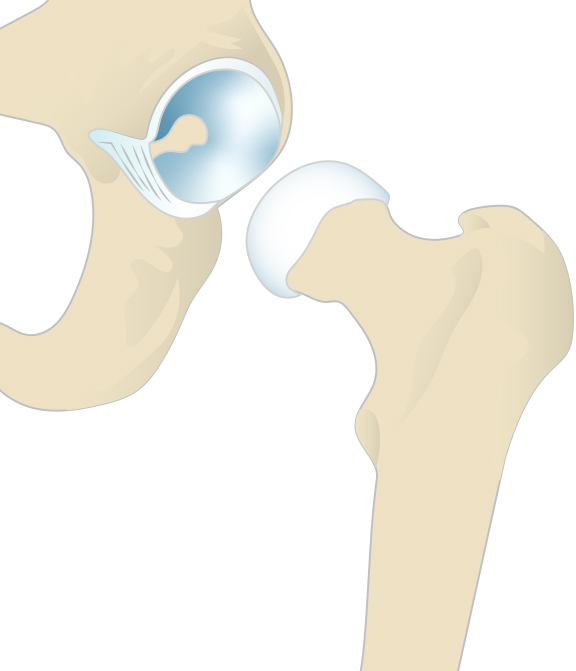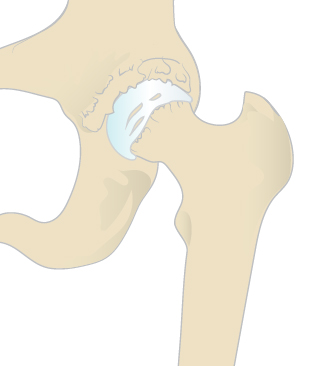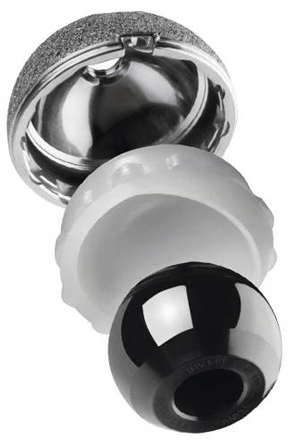Dr. Perez minimal invasive total joint replace
Another total joint replacement done in Victoria not by us
Hip Anatomy/Function
The hip, a ball-and-socket joint, is the largest weight-bearing joint in the body. When the joint is healthy, the head of the femur (thighbone) forms a round ball that fits into the acetabulum, a cavity at the base of the pelvis that forms the socket.
Ligaments connect the ball to the socket and keep them both firmly supported. The surfaces of the femoral head and the acetabulum are covered by a smooth, tough material known as articular cartilage, which cushions the bones and allows them to move easily. Around the rim of the acetabulum is a layer of fibrous cartilage called the labrum, which deepens the socket and provides a suction seal to hold the head of the femur firmly in place.
The other surfaces of the hip joint are covered by a thin, smooth tissue liner called the synovial membrane. This tissue produces a small amount of synovial fluid that acts as a lubricant and reduces the amount of friction that occurs when the bones move against each other.

All information provided on this website is for information purposes only. Every patient's case is unique and each patient should follow his or her doctor's specific instructions. Please discuss nutrition, medication and treatment options with your doctor to make sure you are getting the proper care for your particular situation. If you are seeking this information in an emergency situation, please call 911 and seek emergency help.
All materials copyright © 2023 Smith & Nephew, All Rights Reserved
What is hip arthritis?
What is arthritis of the hip?
Arthritis of the hip is a disease which wears away the cartilage between the femoral head, or hip ball, and the acetabulum, or hip socket, causing the two bones to scrape against each other, raw bone on raw bone. When this happens, the joint becomes pitted, eroded and uneven. The result is pain, stiffness and instability, and in some cases, motion of the leg may be greatly restricted.
Osteoarthritis
Osteoarthritis, which is the most common form of arthritis in the United States, is degenerative and, although it most often occurs in patients over the age of 50, it can occur at any age, especially if the joint is in some way damaged.
It is usually confined to the large weight-bearing joints of the lower extremities, including the hips and knees, but may affect the spine and upper extremity joints, too. Patients with osteoarthritis often develop large bone spurs, or osteophytes, around the joint, further limiting motion.
Rheumatoid arthritis
Unlike osteoarthritis, which is a "wear and tear" phenomenon, rheumatoid arthritis is a chronic inflammatory disease that results in joint pain, stiffness and swelling. The disease process leads to severe, and at times rapid, deterioration of multiple joints, resulting in severe pain and loss of function.
All information provided on this website is for information purposes only. Every patient's case is unique and each patient should follow his or her doctor's specific instructions. Please discuss nutrition, medication and treatment options with your doctor to make sure you are getting the proper care for your particular situation. If you are seeking this information in an emergency situation, please call 911 and seek emergency help.
All materials copyright © 2023 Smith & Nephew, All Rights Reserved
Arthritis of the hip is a disease which wears away the cartilage between the femoral head, or hip ball, and the acetabulum, or hip socket, causing the two bones to scrape against each other, raw bone on raw bone. When this happens, the joint becomes pitted, eroded and uneven. The result is pain, stiffness and instability, and in some cases, motion of the leg may be greatly restricted.
Osteoarthritis
Osteoarthritis, which is the most common form of arthritis in the United States, is degenerative and, although it most often occurs in patients over the age of 50, it can occur at any age, especially if the joint is in some way damaged.
It is usually confined to the large weight-bearing joints of the lower extremities, including the hips and knees, but may affect the spine and upper extremity joints, too. Patients with osteoarthritis often develop large bone spurs, or osteophytes, around the joint, further limiting motion.

Rheumatoid arthritis
Unlike osteoarthritis, which is a "wear and tear" phenomenon, rheumatoid arthritis is a chronic inflammatory disease that results in joint pain, stiffness and swelling. The disease process leads to severe, and at times rapid, deterioration of multiple joints, resulting in severe pain and loss of function.
All information provided on this website is for information purposes only. Every patient's case is unique and each patient should follow his or her doctor's specific instructions. Please discuss nutrition, medication and treatment options with your doctor to make sure you are getting the proper care for your particular situation. If you are seeking this information in an emergency situation, please call 911 and seek emergency help.
All materials copyright © 2023 Smith & Nephew, All Rights Reserved
What is the Anterior Approach with OXINIUM
OXINIUM◊ Anterior
What is OXINIUM◊ Oxidized Zirconium?If it is determined that an implant made with VERILAST◊ technology is right for you, the femoral head, or ball of your implant, will be made from OXINIUM Oxidized Zirconium - a patented ceramicised metal alloy that Smith & Nephew spent more than a decade developing.
During manufacture, OXINIUM implants undergo a process that transforms the implant's surface into a hard, ceramicised metal while still retaining all of the durability of the underlying metal. In addition to being more durable than a true ceramic, this metal implant's ceramicised surface is more than twice as hard and therefore twice as resistant to the kind of scratching that can cause a cobalt chrome implant to wear out before its time. 1

Important safety notes
Hip replacement surgery is intended to relieve hip pain and improve hip function. However, implants may not produce the same feel or function as your original hip. There are potential risks with hip replacement surgery such as loosening, fracture, dislocation, wear and infection that may result in the need for additional surgery. Longevity of implants depends on many factors, such as types of activities and weight. Do not perform high impact activities such as running and jumping unless your surgeon tells you the bone has healed and these activities are acceptable. Early device failure, breakage or loosening may occur if you do not follow your surgeon's limitations on activity level. Early failure can happen if you do not guard your hip joint from overloading due to activity level, failure to control body weight, or accidents such as falls. Talk to your doctor to determine what treatment may be best for you.
References
- Zardiackas, Lyle D., Kraay, Matthew J., Freese, Howard L, editors. Titanium, Niobium, Zirconium, and Tantalum for Medical and Surgical Applications ASTM special technical publication; 1471. Ann Arbor, MI: ASTM, Dec. 2005
All information provided on this website is for information purposes only. Every patient's case is unique and each patient should follow his or her doctor's specific instructions. Please discuss nutrition, medication and treatment options with your doctor to make sure you are getting the proper care for your particular situation. If you are seeking this information in an emergency situation, please call 911 and seek emergency help.
All materials copyright © 2023 Smith & Nephew, All Rights Reserved
What is Total Hip Replacement
What is hip replacement surgery?
Is total hip replacement surgery for you?The good news is that if you are considering total hip replacement surgery, you're not alone. According to the hospital billing data, each year more than 340,000 such procedures are performed in the US.1 Even better news is that the US Department of Health and Human services considers total hip replacement to be one of the most successful and cost effective interventions in medicine.1 In fact, the success rate for hip replacements 10 years after surgery is 90-95%.1

Of course, the decision to have hip replacement surgery should be a cooperative one made by you, your family, your primary care doctor, and your orthopaedic surgeon. The process of making this decision typically begins with a referral by your primary care doctor to an orthopaedic surgeon for an initial evaluation.
Important safety notes
Hip replacement surgery is intended to relieve hip pain and improve hip function. However, implants may not produce the same feel or function as your original hip. There are potential risks with hip replacement surgery such as loosening, fracture, dislocation, wear and infection that may result in the need for additional surgery. Longevity of implants depends on many factors, such as types of activities and weight. Do not perform high impact activities such as running and jumping unless your surgeon tells you the bone has healed and these activities are acceptable. Early device failure, breakage or loosening may occur if you do not follow your surgeon's limitations on activity level. Early failure can happen if you do not guard your hip joint from overloading due to activity level, failure to control body weight, or accidents such as falls. Talk to your doctor to determine what treatment may be best for you.
References
- American Academy of Orthopaedic Surgeon website, orthoinfo.aaos.org/topic.cfm?topic=A00377
All information provided on this website is for information purposes only. Every patient's case is unique and each patient should follow his or her doctor's specific instructions. Please discuss nutrition, medication and treatment options with your doctor to make sure you are getting the proper care for your particular situation. If you are seeking this information in an emergency situation, please call 911 and seek emergency help.
All materials copyright © 2023 Smith & Nephew, All Rights Reserved
ABLE
ABLE Anterior approach for hip replacement
If you've been told you are a candidate for hip replacement surgery, you may benefit from a minimally invasive surgical technique called ABLE Anterior hip replacement surgery. Put simply, this technique changes the direction from which a surgeon can access your hip joint.
With the ABLE Anterior approach, your specially trained orthopedic surgeon is able to repair your painful hip through a natural space between the muscles of the anterior (front) portion of the hip, rather than making the incision on the posterior (back) side, which has the potential of damaging the muscles that make up the primary support system for the joint. These are the muscles you spend weeks and months rehabilitating after surgery.
During this procedure the hip joint is exposed between the anterior muscles, without the need to cut tissue or detach tendons. Once access is gained, the portion of the upper thigh bone (the femoral head and neck) and the hip socket (acetabulum) are prepared for the insertion of the hip replacement implant, just as in a traditional procedure.
The hip replacement is comprised of metal and plastic components that replace the ball-and-socket elements of the hip joint. They are secured within the femur (thighbone) and acetabulum (hip socket) either with bone cement or by "press-fit," meaning the implants are shaped to achieve stability without bone cement. Through the use of X-rays, physicians can ensure the implants have the proper fit and alignment to ensure comfort and a natural range-of-motion after surgery.
Smith & Nephew offers a wide range of hip replacement implants and your surgeon will choose the most appropriate one for you. One consideration used in selecting your implant may be its resistance to the scratching and abrasion that can cause an implant to wear out before its time.
Advantages to utilizing the ABLE Anterior approach
This minimally invasive technique allows for preservation of the soft tissue surrounding the joint, allowing for immediate stability following surgery, as well as a possible lower risk of dislocation, as the primary support muscles are left intact.
Patients may have a shorter hospital stay, as there are typically fewer post-operative restrictions and the possibility of a faster healing time associated with this technique.
Important safety notes
Hip replacement surgery is intended to relieve hip pain and improve hip function. However, implants may not produce the same feel or function as your original hip. There are potential risks with hip replacement surgery such as loosening, fracture, dislocation, wear and infection that may result in the need for additional surgery. Longevity of implants depends on many factors, such as types of activities and weight. Do not perform high impact activities such as running and jumping unless your surgeon tells you the bone has healed and these activities are acceptable. Early device failure, breakage or loosening may occur if you do not follow your surgeon's limitations on activity level. Early failure can happen if you do not guard your hip joint from overloading due to activity level, failure to control body weight, or accidents such as falls. Talk to your doctor to determine what treatment may be best for you.
All information provided on this website is for information purposes only. Every patient's case is unique and each patient should follow his or her doctor's specific instructions. Please discuss nutrition, medication and treatment options with your doctor to make sure you are getting the proper care for your particular situation. If you are seeking this information in an emergency situation, please call 911 and seek emergency help.
All materials copyright © 2023 Smith & Nephew, All Rights Reserved
If you've been told you are a candidate for hip replacement surgery, you may benefit from a minimally invasive surgical technique called ABLE Anterior hip replacement surgery. Put simply, this technique changes the direction from which a surgeon can access your hip joint.
With the ABLE Anterior approach, your specially trained orthopedic surgeon is able to repair your painful hip through a natural space between the muscles of the anterior (front) portion of the hip, rather than making the incision on the posterior (back) side, which has the potential of damaging the muscles that make up the primary support system for the joint. These are the muscles you spend weeks and months rehabilitating after surgery.
During this procedure the hip joint is exposed between the anterior muscles, without the need to cut tissue or detach tendons. Once access is gained, the portion of the upper thigh bone (the femoral head and neck) and the hip socket (acetabulum) are prepared for the insertion of the hip replacement implant, just as in a traditional procedure.

The hip replacement is comprised of metal and plastic components that replace the ball-and-socket elements of the hip joint. They are secured within the femur (thighbone) and acetabulum (hip socket) either with bone cement or by "press-fit," meaning the implants are shaped to achieve stability without bone cement. Through the use of X-rays, physicians can ensure the implants have the proper fit and alignment to ensure comfort and a natural range-of-motion after surgery.
Smith & Nephew offers a wide range of hip replacement implants and your surgeon will choose the most appropriate one for you. One consideration used in selecting your implant may be its resistance to the scratching and abrasion that can cause an implant to wear out before its time.
Advantages to utilizing the ABLE Anterior approach
This minimally invasive technique allows for preservation of the soft tissue surrounding the joint, allowing for immediate stability following surgery, as well as a possible lower risk of dislocation, as the primary support muscles are left intact.
Patients may have a shorter hospital stay, as there are typically fewer post-operative restrictions and the possibility of a faster healing time associated with this technique.
Important safety notes
Hip replacement surgery is intended to relieve hip pain and improve hip function. However, implants may not produce the same feel or function as your original hip. There are potential risks with hip replacement surgery such as loosening, fracture, dislocation, wear and infection that may result in the need for additional surgery. Longevity of implants depends on many factors, such as types of activities and weight. Do not perform high impact activities such as running and jumping unless your surgeon tells you the bone has healed and these activities are acceptable. Early device failure, breakage or loosening may occur if you do not follow your surgeon's limitations on activity level. Early failure can happen if you do not guard your hip joint from overloading due to activity level, failure to control body weight, or accidents such as falls. Talk to your doctor to determine what treatment may be best for you.
All information provided on this website is for information purposes only. Every patient's case is unique and each patient should follow his or her doctor's specific instructions. Please discuss nutrition, medication and treatment options with your doctor to make sure you are getting the proper care for your particular situation. If you are seeking this information in an emergency situation, please call 911 and seek emergency help.
All materials copyright © 2023 Smith & Nephew, All Rights Reserved
POLAR3
The Polar3◊ Total Hip Solution
POLARSTEM◊ + VERILAST◊ Technology + R3◊
Trusted Technology. Trusted Performance.

Chances are, if you've landed on this site it's because you or someone you know is considering total hip replacement. Chances are also pretty good that this means you have questions... lots and lots of questions. We understand and have designed this site to answer as many of these questions as possible. However, we strongly advise that you also talk to your surgeon about these questions and about all of the information you've found on this site. After all, no website can possibly know what's best for you or any other patient. Only by talking with your surgeon about all of your options will you be able to determine the right treatment for you.
Outcomes that outperform
According to the 2017 report of the National Joint Registry for England, Wales, Northern Ireland and the Isle of Man (NJREW), with 99.02% implant survivorship, POLARSTEM with R3 is the best performing hip combination at 7 years regardless of fixation method.1
When compared against the class average of cementless constructs in the NJREW, POLARSTEM has a:
- 46% reduction in overall femoral revision2
- 36% reduction in risk of dislocation2
- 61% reduction in risk of aseptic loosening2
Similarly, the R3 Acetabular System has a:
- 55% reduction in the overall risk of acetabular revision3
- 77% reduction in the revision risk from aseptic loosening3
- 44% reduction in the revision risk from malalignment of the socket3
The POLAR3◊ Total Hip Solution
One of the most exciting hip replacement options on the market today is the POLAR3 Total Hip Solution. Although we call it a single solution, it is actually made up of three proprietary technologies that, when combined, can deliver extraordinary results that are designed to improve surgical outcomes and maximize patient satisfaction. Of course, you shouldn't just take our word for it. Instead, let's look at what is being reported in one of the largest joint registries around the world.
The POLAR3 System is a total hip solution, meaning that it includes a hip stem, a hip head and an acetabular cup. Together, these three components are designed to replace the ball and socket structure of your natural hip.
Important safety notes
Hip replacement surgery is intended to relieve hip pain and improve hip function. However, implants may not produce the same feel or function as your original hip. There are potential risks with hip replacement surgery such as loosening, fracture, dislocation, wear and infection that may result in the need for additional surgery. Longevity of implants depends on many factors, such as types of activities and weight. Do not perform high impact activities such as running and jumping unless your surgeon tells you the bone has healed and these activities are acceptable. Early device failure, breakage or loosening may occur if you do not follow your surgeon's limitations on activity level. Early failure can happen if you do not guard your hip joint from overloading due to activity level, failure to control body weight, or accidents such as falls. Talk to your doctor to determine what treatment may be best for you.
References
- National Joint Registry for England, Wales and Northern Ireland: 14th Annual Report. 2017
- National Joint Registry for England, Wales and Northern Ireland. Implant Summary Report for POLARSTEM, dated 16 May 2018.
- National Joint Registry for England, Wales and Northern Ireland. Implant Summary Report for R3, dated 16 May 2018
All information provided on this website is for information purposes only. Every patient's case is unique and each patient should follow his or her doctor's specific instructions. Please discuss nutrition, medication and treatment options with your doctor to make sure you are getting the proper care for your particular situation. If you are seeking this information in an emergency situation, please call 911 and seek emergency help.
All materials copyright © 2023 Smith & Nephew, All Rights Reserved.
XLPE
What is XLPE?
What is XLPE or highly cross-linked plastic?As remarkable as OXINIUM◊ Oxidized Zirconium is, it is the combination of the OXINIUM material on XLPE that makes VERILAST◊ Technology.
XLPE is created by altering chemical bonds in the polyethylene we use to create our plastic inserts. By doing so, we are able to create a tighter weave at the molecular level, thus reducing the amount of wear experienced when the metal component rubs against it. Perhaps the easiest way to think of it is like a
.jpg) fabric with a higher thread count.
fabric with a higher thread count.Important safety notes
Hip replacement surgery is intended to relieve hip pain and improve hip function. However, implants may not produce the same feel or function as your original hip. There are potential risks with hip replacement surgery such as loosening, fracture, dislocation, wear and infection that may result in the need for additional surgery. Longevity of implants depends on many factors, such as types of activities and weight. Do not perform high impact activities such as running and jumping unless your surgeon tells you the bone has healed and these activities are acceptable. Early device failure, breakage or loosening may occur if you do not follow your surgeon's limitations on activity level. Early failure can happen if you do not guard your hip joint from overloading due to activity level, failure to control body weight, or accidents such as falls. Talk to your doctor to determine what treatment may be best for you.
All information provided on this website is for information purposes only. Every patient's case is unique and each patient should follow his or her doctor's specific instructions. Please discuss nutrition, medication and treatment options with your doctor to make sure you are getting the proper care for your particular situation. If you are seeking this information in an emergency situation, please call 911 and seek emergency help.
All materials copyright © 2023 Smith & Nephew, All Rights Reserved
OXINIUM Total Hip
VERILAST◊ Hip OXINIUM◊
What is OXINIUM◊ Oxidized Zirconium◊If it is determined that an implant made with VERILAST◊ technology is right for you, the femoral head or ball of your implant will be made from OXINIUM Oxidized Zirconium - a patented ceramicised metal alloy that Smith & Nephew spent more than a decade developing.
During manufacture, OXINIUM implants undergo a process that transforms the zirconium surface into a hard, ceramicised metal - while still retaining all of the durability of the underlying metal. This means that it won't fracture like a true ceramic, yet its ceramicised surface is more than twice as hard and therefore twice as resistant to the kind of scratching that can cause a cobalt chrome implant to wear out before its time.1
.jpg)
Important safety notes
Hip replacement surgery is intended to relieve hip pain and improve hip function. However, implants may not produce the same feel or function as your original hip. There are potential risks with hip replacement surgery such as loosening, fracture, dislocation, wear and infection that may result in the need for additional surgery. Longevity of implants depends on many factors, such as types of activities and weight. Do not perform high impact activities such as running and jumping unless your surgeon tells you the bone has healed and these activities are acceptable. Early device failure, breakage or loosening may occur if you do not follow your surgeon's limitations on activity level. Early failure can happen if you do not guard your hip joint from overloading due to activity level, failure to control body weight, or accidents such as falls. Talk to your doctor to determine what treatment may be best for you.
References
- Zardiackas, Lyle D., Kraay, Matthew J., Freese, Howard L, editors. Titanium, Niobium, Zirconium, and Tantalum for Medical and Surgical Applications ASTM special technical publication; 1471. Ann Arbor, MI: ASTM, Dec. 2005
All information provided on this website is for information purposes only. Every patient's case is unique and each patient should follow his or her doctor's specific instructions. Please discuss nutrition, medication and treatment options with your doctor to make sure you are getting the proper care for your particular situation. If you are seeking this information in an emergency situation, please call 911 and seek emergency help.
All materials copyright © 2023 Smith & Nephew, All Rights Reserved

